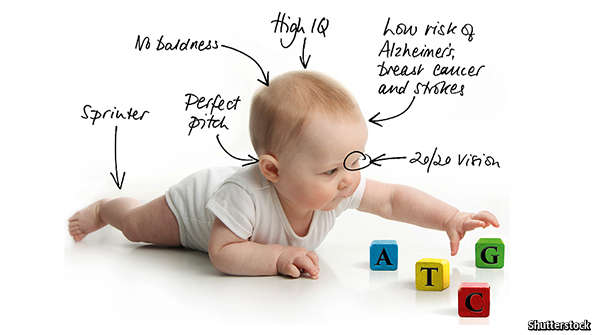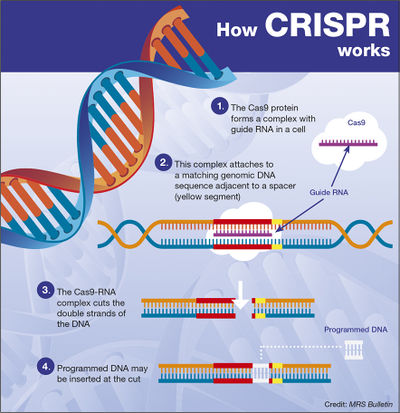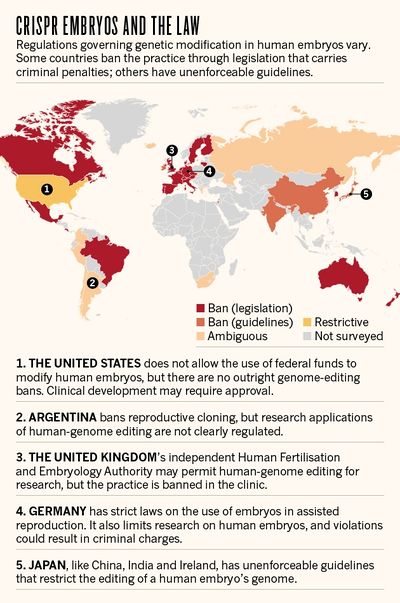GRSJ224/Human Genetic Engineering
Definition of Human Genetic Engineering
Genetic Engineering
Genetic engineering, also called genetic modification, is the deliberate and controlled modification or manipulation of an organism's genetic makeup; thereby, producing new types of organisms. DNA is inserted, deleted or replaced in the genome of a living organism.
Designer Baby
A Designer Baby is a human embryo which its genetic makeup has been modified for specially selected traits, which can vary from lowered disease-risk to gender selection. The genetic enhancement is possible via a bio-technology called, CRISPR-CAS 9, and the birth of such babies is done using various methods, such as gene therapy or Preimplantation Genetic Diagnosis (PGD).

History of Human Genetic Engineering
1900s
The first gene map, Drosophila, was created in 1911 by Alfred Sturtevant. [1]
1950s
In 1953, Francis Crick and James Watson discovered the double helical structure of the DNA molecule which facilitated the crucial first step in molecular genome analysis.[2]
1970s
Patrick Steptoe and Robert Edwards pioneered a new contraceptive method called In Vitro Fertilization in 1977. [3]
1980s
The initial discussions about the feasibility and value of conducting the Human Gene Project first arose in 1986. The following year, the first automated DNA sequencer was produced commercially.[4] This technological advancement was critical for the Human Gene Project as it enabled researchers to decode millions, as opposed to thousands, of letters of genetic code per day.
1990s
Finally in 1990, Human Genome Project was initiated.
2000s
In early 2001, it was publicized in a scientific journal that 90 percent of the human genome's three billion base-pairs have been sequenced. [5] Two years later, in 2003, the Human Genome Project was completed. The "postgenomic" era began with controversies about the direction of genetic research, human cloning, stem cell research, and genetically modified food and crops.
2010s
Scientists claimed Designer Babies can be created by modifying their genetic information when they are an embryo, usually following guidelines created by scientists or parents.
2015
It has been proven that CRISPR can be used to cut HIV viruses out of living cells from patients in the lab. [6]
2016
As an alternative to Homology Directed Repair- and Non-Homologous End Joining- dependent genome editing, CRISPR-dependent editing strategies, which directly modifies DNA bases, have recently been developed. [7]
Technology
CRISPR-CAS9
Until recently, gene editing was extremely expensive, complicated and time-consuming; however, with the advancement of a new bio-technology called CRISPR, also known as CRISPR-CAS9, the costs of gene experimenting have reduced and anyone with a lab can conduct an experiment. CRISPR is known as a "molecular scissor" because it has the ability to cut and insert specifically targeted DNAs.

Major Benefits
The predictive future possibilities of human genetic engineering using CRISPR is endless.
Better Life
Genetic engineering with the advancement of CRISPR, is beneficial for humans because it helps in destroying diseases. As many genetic diseases are caused by a single incorrect letter in the DNA sequence, CRISPR can eventually end the recurring genetic diseases. Moreover, scientists are trying to solve how a cancer cell can be edited, using CRISPR.[8] In the end, the society would benefit from having no sickness whether it is mildly annoying or it entails decades of suffering. Another benefit scientists are hoping to accomplish is slowing the aging process. [9] Provided that one has decent wage and is free of sickness, living longer may sound tempting to most people.
Reproductive Freedom
With the advancement of bio-technologies, we already have the ability to distinguish certain genetic features of fetuses. Some people argue that bio-technologies like CRISPR empowers parents to make choices about their baby and their future. [10] Some parents may want to abort the baby if the baby has a disability or genetic disease the parents cannot afford to treat.
Major Challenges
The advancement of bio-technology is astonishing and can definitely be beneficial. However, there are great challenges that cannot be overlooked when discussing the advancement in human genetic engineering via CRISPR.
Technological Challenges
The technologies of genetic modification and selection still must be verified that it is safe to be used on humans. Since CRISPR-CAS9 is quite a new bio-technology, there may be crucial problems that must fixed before we implement CRISPR on humans. Technological problems may occur, and errors may follow even after we perfect the technology.
Ethical Challenges
The obvious ethical challenge that arise for using CRISPR to create designer babies is: Is it ever right to edit human genes that are inherited? Or should parents be permitted to "enhance" their children without the children's consent? Also, who will be responsible for the changes in one's life if CRISPR brings unexpected problems later in a child's life? Some argue that we should reject the idea of practicing CRISPR (Designer Babies) as it reminds them of Nazi eugenics strategy of "selective breeding" because Adolph Hitler tried to rebuild the nation's population by killing the "inferiors" in the past. [11]
Political Challenges
Whether one can use CRISPR or make Designer Babies depend on their citizenship status. There are some countries, such as Canada, that ban practicing CRISPR on human embryos for research. Moreover, bioethicists found that 29 out of 39 countries have regulations that could be interpreted as restricting genome editing for clinical use. [12]

Discussion
Although human genetic engineering can be very beneficial in many ways, whether we allow or ban CRISPR and Designer Babies will have a gradual, but irreversible changes to the human gene pool. Not only that, it may bring an array of concerns. Some, depending on their financial status, may or may not be able to afford CRISPR whether it is for curing an illness or creating the perfect baby. Also, one's religion and citizenship status would determine whether they access CRISPR. Moreover, this division of groups - people who can and cannot access CRISPR, or people who are born with designed-talents or natural talents - may cause discrimination in the society. For example, using CRISPR may create a visible representation of one's financial and social status. Moreover, discriminations such as ableism and ageism may occur with the advancement of genetic enhancement. Such discriminations in the society may lead to changes in the legal, immigration and educational systems. For example, people who have been modified to be closer to "perfect" with longer expected life period, supernatural ability and no health complications may be favoured in such system.
References
- ↑ Sturtevant, A. H. (1913). The linear arrangement of six sex‐linked factors in Drosophila, as shown by their mode of association. Journal of Experimental Zoology Part A: Ecological Genetics and Physiology, 14(1), 43-59.
- ↑ Watson, J. D., & Crick, F. H. (1953). Genetical implications of the structure of deoxyribonucleic acid. Nature, 171(4361), 964-967.
- ↑ Edwards, R., & Steptoe, P. (1980). A matter of life: The story of a medical breakthrough.
- ↑ Connell, C., Fung, S., Heiner, C., Bridgham, J., Chakerian, V., Heron, E., ... & Recknor, M. (1987). Automated DNA-sequence analysis. BioTechniques, 5(4), 342.
- ↑ Vitkup, D., Melamud, E., Moult, J., & Sander, C. (2001). Completeness in structural genomics. Nature Structural & Molecular Biology, 8(6), 559-566.
- ↑ Hou, P., Chen, S., Wang, S., Yu, X., Chen, Y., Jiang, M., ... & Guo, D. (2015). Genome editing of CXCR4 by CRISPR/cas9 confers cells resistant to HIV-1 infection. Scientific reports, 5, 15577.
- ↑ Komor, A. C., Kim, Y. B., Packer, M. S., Zuris, J. A., & Liu, D. R. (2016). Programmable editing of a target base in genomic DNA without double-stranded DNA cleavage. Nature, 533(7603), 420-424.
- ↑ Platt, R. J., Chen, S., Zhou, Y., Yim, M. J., Swiech, L., Kempton, H. R., ... & Graham, D. B. (2014). CRISPR-Cas9 knockin mice for genome editing and cancer modeling. Cell, 159(2), 440-455.
- ↑ Libertini, G., & Ferrara, N. (2016). Possible interventions to modify aging. Biochemistry (Moscow), 81(12), 1413-1428.
- ↑ Savulescu, J. (2002). Deaf lesbians,“designer disability,” and the future of medicine. BMJ: British Medical Journal, 325(7367), 771.
- ↑ Malinowski, M. J. (2003). Choosing the Genetic Makeup of Children: Our Eugenics Past-Present, and Future. Conn. L. Rev., 36, 125.
- ↑ Araki, M., & Ishii, T. (2014). International regulatory landscape and integration of corrective genome editing into in vitro fertilization. Reproductive biology and endocrinology, 12(1), 108.